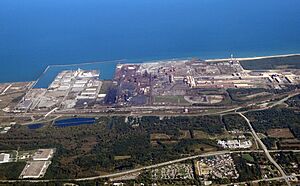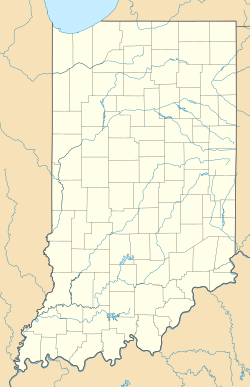Port of Indiana facts for kids
Quick facts for kids Ports of Indiana-Burns Harbor |
|
|---|---|
 |
|
| Location | |
| Coordinates | 41°38′38″N 87°09′18″W / 41.644°N 87.155°W |
| Website http://www.portsofindiana.com/ |
|
The Ports of Indiana-Burns Harbor is a busy shipping port in Indiana. It is owned by the state of Indiana. This port helps move goods by ship across Lake Michigan and beyond. The Indiana Port Commission was created in 1961 to plan and open ports like this one.
The Ports of Indiana-Burns Harbor opened in 1970. You can find it on Lake Michigan where U.S. Route 12 and Indiana State Road 249 meet. A lot of steel is made in this area. Many businesses at the port work with steel. Other companies handle farm products and different goods. The port is located between the towns of Burns Harbor and Portage.
Building the port was a big project. It was built on a part of the Indiana Dunes. This area was once home to important sand dunes. It was also where early flight experiments happened. A famous aviator named Octave Chanute did some of his hanggliding tests here. The creation of the Indiana Dunes National Park helped protect other parts of the dunes. This park now borders the port on three sides.
Contents
What Is Shipped at the Port?
The Ports of Indiana-Burns Harbor is surrounded by large factories. These factories use the port to ship their products and receive materials.
- Steel Mills: Two major steel companies have plants nearby.
- One is the Gary Works-Midwest Plant, part of the U.S. Steel Corporation.
- The other is the Burns Harbor steel works, now owned by Cleveland-Cliffs. It was first built by Bethlehem Steel.
- Power Station: There is also a power plant nearby. It is called the Northern Indiana Public Service Bailly generating station. It is currently not running but can be started if needed.
How the Port Was Built
Building the port and steel mills in the Burns Harbor area was a huge task. The water in Lake Michigan near the sand dunes was too shallow for large ships. To fix this, a lot of digging and engineering work was needed. This work helped connect the Little Calumet River to Lake Michigan. This connection is called Burns Ditch or Portage Burns Waterway.
The United States Army Corps of Engineers helped build and maintain the port. They made sure the docking areas were deep enough for large ships. These areas are at least 27 feet (8 meters) deep. The port is also protected by long walls called breakwaters. These walls are made of steel and rocks.
The state of Indiana also helped the port project. They built two roads, State Road 149 and State Road 249. These roads help trucks get to and from the port. In 2024, a bridge on State Road 249 was made wider. This could help even more cargo move through the port.
Fun Near the Port
Next to the Ports of Indiana-Burns Harbor is the Burns Waterway Small Boat Harbor. This is a canal that is about 5,540 feet (1,689 meters) long. It is 6 feet (1.8 meters) deep. This canal lets small boats travel from Lake Michigan to the Portage Marina. There was also a plan for a private marina and housing complex called Marina Shores. The marina part was successful, but the housing was not built.
Many people think the Ports of Indiana-Burns Harbor owns the Burns Waterway. But it is actually maintained by the United States Army Corps of Engineers. The state-owned port is a "restricted area." This means the public cannot go into most of the port area. However, you can visit the port office.
Keeping the Environment Safe
Sometimes, accidents can happen at large industrial sites. In 2019, a steel mill accidentally released some chemicals into the Little Calumet River. This caused harm to many fish. A public fishing spot near the port was closed for a while. The company that owned the mill later agreed to pay money to help fix the environment. This money helps support efforts to keep the river clean and safe for wildlife.


